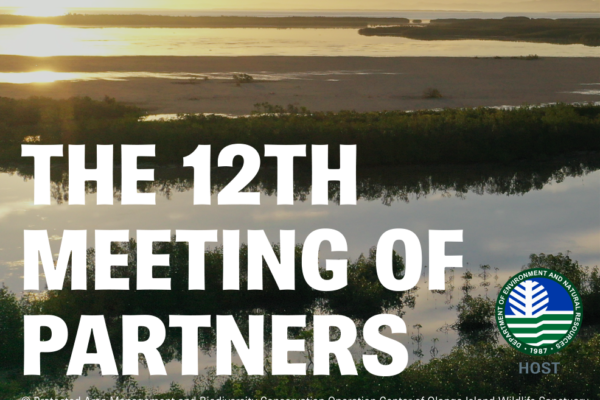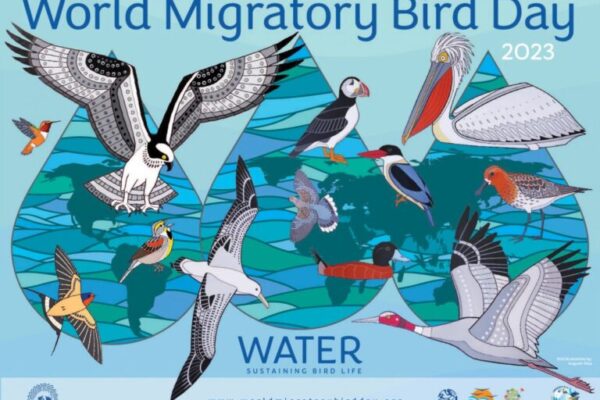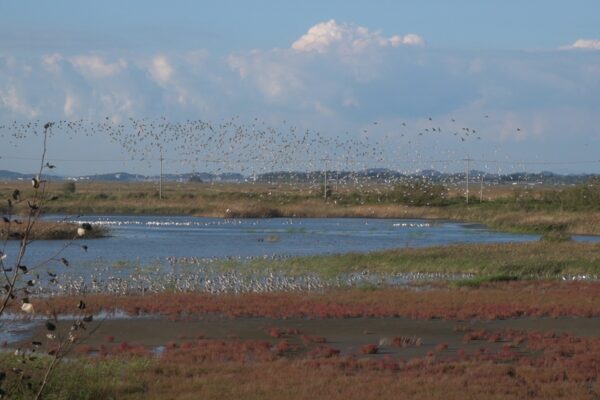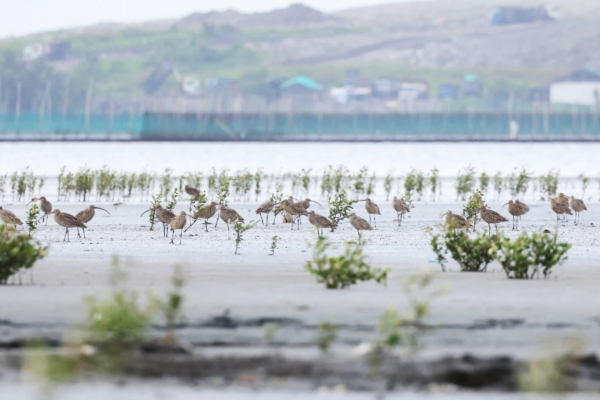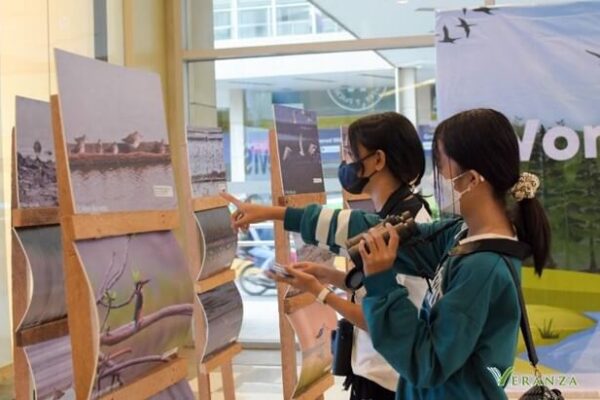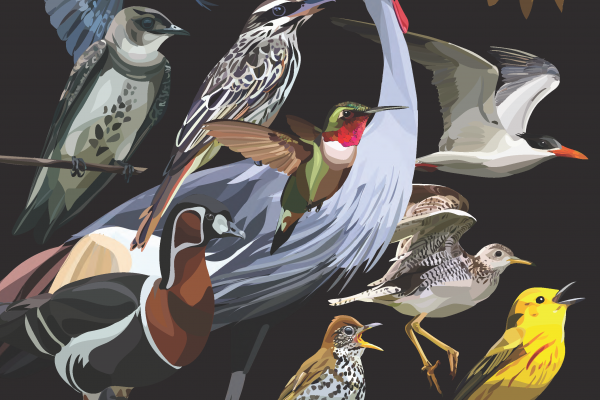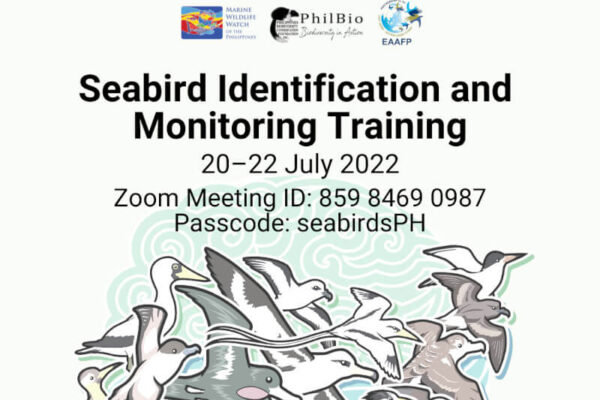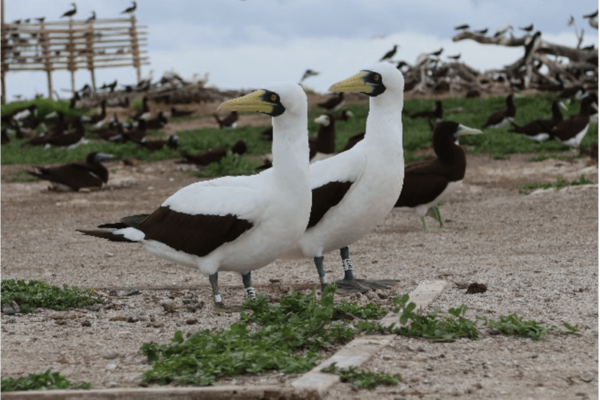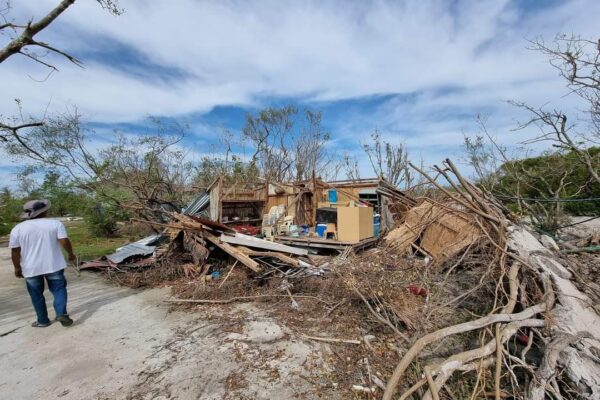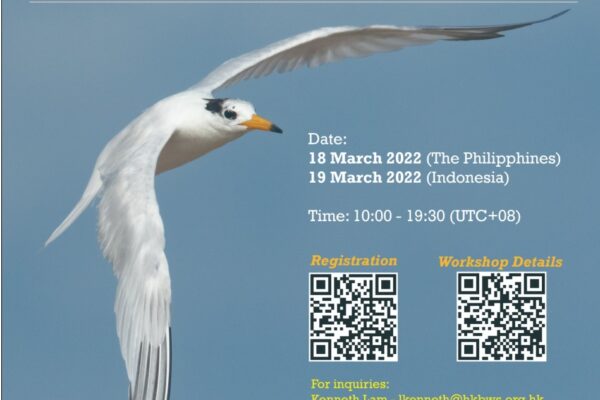-
World Migratory Bird Day 2023 highlights impact of the growing water crisis on migratory birds
BOULDER/BONN/INCHEON, 13 May 2023 – Water and its importance to migratory birds – and the increasing threats to both water quality and quantity - is the focus of this year’s World Migratory Bird Day, a global campaign that aims to raise awareness of migratory birds and the need for international cooperation to conserve them. Activities to mark the campaign will be held globally on two peak days in May and October under the theme “Water: Sustaining Bird Life” Water is fundamental to sustaining life on our planet. Migratory birds rely on water and its associated habitats—lakes, rivers, streams, ponds, swamps, marshes, and coastal wetlands—for breeding, resting, refueling during migration, and wintering. Yet increasing human demand for water, along with climate change, pollution, and other factors, are threatening these precious aquatic ecosystems. Headlines around the world are sounding alarm: 35 percent of the world’s wetlands, critical to migratory birds, have been lost in the last 50 years. Utah’s Great Salt Lake, the largest saltwater lake in the Western Hemisphere and used by more than a million shorebirds, is in danger of disappearing within five years. Across the Amur-Heilong Basin in Asia, climate change is amplifying the impact of habitat destruction by depleting natural water systems and depriving migratory birds of vital breeding and stopover site. These sobering examples go hand-in-hand with recent reports that reveal that 48 percent of bird species worldwide are undergoing population declines. Another poignant example is that of the Aral Sea shared by Kazakhstan and Uzbekistan. Once the fourth-largest lake in the world, it is widely regarded as one of the planet’s worst water-related environmental disasters. Soviet-era irrigation projects almost completely dried up the lake, which led to the loss of livelihoods for fishermen and farmers and the deterioration of public health due to toxic dust and reduced access to clean water. The impact has been severe for the communities around the lake, but also for migratory birds, which lost important food sources and a critically important stopover point on their journey. Another example is the Sahel, a vast semi-arid region in Africa: Prolonged periods of drought, deforestation, and overgrazing in the Sahel have led to the degradation of the soil and loss of vegetation, threatening the survival of both the local human population and wildlife, including migratory birds. Lake Chad, one of the largest water bodies in Africa in 1960, lost 90 % of its area, depleting water resources for local communities and also for many migratory birds. World Migratory Bird Day serves as an international call to action for the protection of migratory birds, whose ranges often span multiple countries, and are facing many different threats worldwide. The annual campaign is organized by the Convention on the Conservation of Migratory Species of Wild Animals (CMS), the African-Eurasian Migratory Waterbird Agreement (AEWA), Environment for the Americas (EFTA), and the East Asian-Australasian Flyway Partnership (EAAFP). World Migratory Bird Day 2023 will be officially held on 13 May and 14 October. The two days of World Migratory Bird Day reflect the cyclical nature of bird migration as well as the fact that there are varying peak migration periods in the northern and southern hemispheres. Events to raise awareness of migratory birds and the importance of water will take place all over the world including in local parks, nature centers, museums, libraries, schools, and other locations on these peak days and throughout the year. To learn more about this year’s World Migratory Bird Day campaign and actions to take, visit www.worldmigratorybirdday.org and EAAFP WMBD 2023 webpage: https://www.eaaflyway.net/world-migratory-bird-day-2023/ Also, please have a look of the Campaign Strategy for promoting World Migratory Bird Day, click [here]. For more resources, visit the Trello Board [here]. Message from the Partners of World Migratory Bird Day Convention on Migratory Species (CMS) “Water is essential for people as well as for migratory birds and other wild species of animals. Yet around the world, the availability and quality of water is under enormous pressure, with deeply concerning implications. The looming global water crisis requires urgent action by governments, businesses, local communities as well as individuals. Because migratory birds cross national borders and even continents, international cooperation is essential to ensure that actions are taken to conserve and restore important habitat for migratory birds, and to address the drivers of water loss, pollution, and climate change,” said Amy Fraenkel, Executive Secretary of the Convention on the Conservation of Migratory Species of Wild Animals (CMS). African-Eurasian Migratory Waterbird Agreement (AEWA) “The water crisis recently highlighted by the UN 2023 Water Conference also has a tremendous impact on migratory birds. In the Sahel in particular, many wetlands on which migratory waterbirds rely during the non-breeding period are shrinking. Water is a vital resource for all, local communities as well as birds. By reducing our consumption, combatting climate change, and managing wetlands wiser, we can improve the situation,” said Dr. Jacques Trouvilliez, Executive Secretary of the Agreement on the Conservation of African-Eurasian Migratory Waterbirds (AEWA). Environment for the Americas (EFTA) “World Migratory Bird Day 2023 spotlights the vital role that water plays in the survival of our shared birds. The focal species illustrated on the campaign poster depict the intricate bond each bird shares with water. The diminutive Rufous Hummingbird thrives on nectar-producing flowers that rely on water for their blooms, and the Dickcissel scours the grasslands for seeds that hold the moisture they need. White Pelicans and Ospreys seek their prey in freshwater lakes, while the magnificent Wandering Albatross and Atlantic Puffin remain at sea. WMBD is an opportunity to unify our voices for the conservation of migratory birds and to celebrate their spectacular journeys,” said Dr. Susan Bonfield, Executive Director at Environment for the Americas (EFTA). East Asian-Australasian Flyway Partnership (EAAFP) “This year's WMBD theme serves as a vital reminder of the linkage of migratory birds to the importance of protecting aquatic ecosystems and conserving wetlands. As birds such as threatened Spoon-billed Sandpiper, Dalmatian Pelican, and Sarus Crane migrate, they rely heavily on wetlands for survival. We must take urgent actions and collaborate at all levels, from citizens to among governments, to tackle the problems of saving water and aquatic ecosystem, and ensure that migratory birds continue to thrive.” Ms. Yeounhee Ahn, Deputy Executive of East Asian-Australasian Flyway Partnership (EAAFP).
Continue reading -
Activities of the EAAFP Secretariat for Hwaseong Wetlands Conservation Projects 2020-2022
The scenery of the Hwaseong Wetlands Flyway Network Site © EAAFP Secretariat In November 2018, Hwaseong Wetlands was nominated as the East Asian-Australasian Flyway Network Site (FNS) as its importance as a habitat for migratory waterbirds has been acknowledged. With its designation, Hwaseong City and the EAAFP Secretariat signed an MOU [article] and proceeded with the project called “Collaboration for Conservation of the Hwaseong Wetlands” for three consecutive years, from 2020 to 2022. This article demonstrates the project activities that were carried out in chronological order. <2020> The Project was carried out in six major activities. EAAFP, Birds Korea, Federation for Environmental Movements of Hwaseong (KFEM Hwaseong), Korea Federation for Environmental Movements (KFEM), and Hwaseong City together prepared for the event from June, proceeding with the international symposium online in December 2020. About 300 concurrent users with 2400 views participated and discussed the management of Hwaseong Wetlands together with citizens, farmers, fishermen, the Rural Community Corporation, the Ministry of Oceans and Fisheries, the Ministry of Environment, researchers, international organizations, and overseas experts. Article: Link Follow-up Actions to the Symposium: Production of Guidelines for Hwaseong Wetland Management Plan and Workshops. Based on discussions on the management of Hwaseong Wetlands at the symposium in December 2020, the EAAFP Secretariat presented guidelines for Hwaseong Wetland Management Plan after two workshops and one advisory meeting in February and March 2021. Hwaseong City, Hwaseong Eco Foundation, and the Symposium Task Force team (the EAAFP Secretariat, KFEM, KFEM Hwaseong, and Birds Korea) participated in the workshop to reach an agreement on the direction of Hwaseong Wetland management in 2021 and beyond. The title of the guideline is ‘The Proposal for the Management Directions for the Sustainable use of the Hwaseong Wetlands’ and was referred to domestic and international wetland management plans and management guidelines. This suggestion presents the scope of management, direction of wetland management, partnership establishment, and setting of goals and implementations. It also proposes to form a consultative body when establishing a partnership, to have an implementation organization accordingly, and to entrust it to civic groups, which has not been attempted in Korea. The authors of the guidelines are Ms. Yeonah Ku (EAAFP Secretariat), (KFEM Hwaseong), and Ms. Hyeseon Do (EAAFP Secretariat), members of the Symposium TF. The external manuscript of Han Donguk, the Director of the PGA Wetland Ecology Research Institute, was also included. Article: Link Hwaseong Wetlands Conservation Resident Project The resident project organized by HEFM initially considered the formation of a symposium preparatory committee, but because of the rising number of COVID-19 cases, it was more carried out as an awareness-raising-oriented activity. From July 2020 to March 2021, six meetings, seven campaigns, eight club activities, two discussions, three lectures, five civic ecological research group activities, and one ecological exploration activity were held. Article: Link International Cooperation Project for the Conservation of Far Eastern Curlew The EAAFP Secretariat discussed with EAAFP Far Eastern Curlew Task Force and decided to support the “Far Eastern Curlew Conservation Project in Sumatra Island” and funded the EKSAI Foundation in Indonesia. Through this research, a full investigation of Far Eastern Curlew and waterbirds in northern Sumatra including Sembilang National Park (South Sumatra Province), Pantai Cemara (Jambi Province) and Bagan Serdang (North Sumatra Province) was made, and training was conducted to local guards. Moreover, a report that compares and analyzes with waterbirds data has been written, which is uploaded on the EAAFP website. Article: Link Waterbird-oriented Ecological Survey and Far Eastern Curlew Network Construction Project Organized by Birds Korea and KFEM, ecological surveys at the Hwaseong Wetlands were carried out from June 2020 to March 2021. Through the survey, migration behavior and habitat of migratory waterbirds and their juvenile were identified. Based on the findings, guideline directions were proposed, and the Far Eastern Curlew Network was formed in December 2020. Among the findings, a report written in 2020 is uploaded on the EAAFP website. Related article 1: “Flyway: connecting people and migratory waterbirds” story series #6– Interview with Dr. Nial Moores Related article 2: The Hwaseong Wetlands Project Related article 3: The Launch of Far Eastern Curlew Network of the Korean Peninsula Promotional and Educational Materials Production Project The EAAFP Secretariat produced key species factsheets for public-raise awareness purposes in the East-Asian Australasian Flyway. The nine species were produced in both Korean and English. Article: Link Moreover, EAAFP Secretariat operated Hwaseong Wetlands FNS Facebook from July 2020 and is promoting Hwaseong Wetlands conservation activities. Article: Link Furthermore, prizes for the Hwaseong Wetland Promotion Contest winner were delivered. [Prize-winner] <2021> The Project was carried out in four major activities. International Cooperation Project for the Conservation of Far Eastern Curlew Following the previous activity of the Far Eastern Curlew surveys in Sumatra in Indonesia, the EKSAI Foundation took another series of surveys as well as training local communities in Sumatra. See the results and the reports in the separate article: Link Local Cooperation Project: Far Eastern Curlew Network in the Korean Peninsula Following the suggestion from the EAAFP Secretariat and Birds Korea in 2020 based on the ecological survey in the Hwaseong Wetlands Flyway Network Site (FNS) in 2020 and existing data from the National Institute of Biological Resources (NIBR), three local governments in ROK, Hwaseong City, Seocheon County, Yeonsu District of Incheon City, initiated the Far Eastern Curlew Network in the Korean Peninsula since 1st December 2020. As a secretariat of the network, Hwaseong City supported the Far Eastern Curlew survey held in July 2021, following the advice of Birds Korea and the EAAFP Secretariat. From July 21st to 25th 2021, 26 survey participants counted Far Eastern Curlews and other species at 34 sites in three areas: parts of coastal Incheon (Ganghwa Island, Yeongjong Island and Songdo, the Han Estuary); the adjacent Gyeonggi Coast (the Hwaseong Wetlands and Asan Bay); and the Geum Estuary (Figure 1). Participants are experienced counters with specialist knowledge of their areas. A total of 9,642 Far Eastern Curlews were recorded with 3,746 in Incheon; 3,255 in parts of Gyeonggi mainland coast; and 2,641 in Geum Estuary. This is around a third of the world’s population of the species, which was estimated to be 32,000 individuals (range: 20,000 – 49,000 individuals, source: https://www.iucnredlist.org/) Article: Link Local Residents Support Project: Citizen Ecological Survey, Marine Waste Cleaning, Civic Forum, and Walking Event To promote the importance of the Hwaseong Wetlands and to conserve wetlands in the hands of the local people, the EAAFP Secretariat and the Korean Federation of Environmental Movement–Hwaseong (KFEM Hwaseong) implemented the Local Residents Project for Conservation of the Hwaseong Wetlands from April to December 2021. Through the Project a citizen-based ecological survey group was formed, and ecological surveys and on-site monitoring activities were conducted with the guide led by experts in waterbirds, large benthos, wild animals, and amphibians. The Youth at Durae Natural High School near the Hwaseong Wetlands and instructors working in the region formed a small group (Dingo Club) together and conducted 5 times of indoor and field education activities regarding the Hwseong Wetlands. The students participated in the “Hwaseong Youth Policy Proposal Contest” and proposed policies for establishing the “Hwaseong Wetland Education Center” and won the Excellence Award. A local birdwatching and marine waste cleaning events were also held for the local citizens, providing sufficient education regarding marine waste problems and the importance of waterbirds. Furthermore, A civic forum was held with wetland NGOs, experts, and residents, titled ‘Benefits of the Hwaseong Wetlands, Shared with Together.’ Through the Forum, it was an opportunity to resolve conflicts over wetland development & conservation, seek new directions for reclaimed land in the Hwaseong Wetlands, and emphasize the importance of the Hwaseong Wetlands in and outside Hwaseong City. Lastly, Hwaseong Wetland Citizens’ Walking Event: Life and Peace Road was organized in solidarity with 17 civil society organizations in Suwon and Hwaseong Cities. Walking along the 5km section of the Hwaseong seawall, citizens toured the Hwaseong Wetlands, where numerous lives are alive and breathing, and shared the meaning of peace by listening to the story of the village suffering from 54 years of combat airfield at Maehyang-ri History Hall. Article: Link 2021 International Symposium for the Hwaseong Wetlands – “All Connected through the Hwaseong Wetlands: One World, One Future” On 26th November, the 2021 International Symposium for the Hwaseong Wetlands hosted by Hwaseong City took place at Purmir Hotel, Hwaseong City. Hwaseong Eco Foundation, EAAFP Secretariat, Birds Korea, and Korea Federation for Environmental Movements (KFEM) of Hwaseong co-organized the event, with support from the Ministry of Environment Ministry of Oceans and Fisheries, Cultural Heritage Administration of the Republic of Korea, and Hanns Seidel Foundation Korea. Based on the ideas drawn from the forum, the speakers raised the management and restoration plan on Tidal Flats in ROK with a policy proposal and discussed how to join force for the UNESCO World Natural Heritage Site Phase II. In addition, international experts presented the importance of designating the inland wetlands along the Hwaseong Lake as a Wetland Protected Area and the future management guidelines of the Hwaseong Wetlands with moderation by, Ms. Choony Kim, Secretary General of KFEM. During the panel discussion, the panelists emphasized the importance of designating the inland wetlands along the Hwaseong Lake as a Wetland Protected Area and the future management guideline of the Hwaseong Wetlands. Article: Link Symposium Video Links: Korean, English <2022> The Project was carried out in four major activities. International Cooperation Project for the Conservation of Far Eastern Curlew & domestic cooperation The afterwork has been conducted for the Far Eastern Curlew Conservation Project in Sumatra, Indonesia from January and February. The report document was revised according to the updated information provided by the EKSAI Foundation, the leading organization of the Fare Eastern Curlew Conservation Project in Sumatra. FEC Survey has been conducted in the Philippines from October to December 2022. The surveys were conducted in Bulacan, Malolos City, Pamarawan; National Capital region, Navotas City, Tansa; Cebu, Mandaue City; Negros Island, Negros Occidental; Iloilo City, Iloilo Province; Masbate State, Bicol Region; Oriental Mindoro; and La Union. With this survey there was an opportunity to introduce potentially important habitats for FEC in the Philippines and share survey data. It was reported that further support is required for the continuous implementation of the survey. In the other hand, the Secretariat supported the Hwaeong Eco Foundation and Hwaseong City by holding several meetings/ participating in several education trainings as a domestic cooperation activity. Hwaseong Wetlands Visioning Project In consultation with Wildfowl and Wetlands Trust (WWT) Based in UK, Hwaseong City and the EAAFP Secretariat have discussed the need for developing a visioning plan for the wise use of the Hwaseong Wetlands, which could positively support both wildlife and local residents that rely on the wetland areas. From January 2022, virtual meetings between WWT and the EAAFP Secretariat were held to discuss WWT’s site visit and the organization of stakeholder meeting to receive comprehensive data on the Hwaseong Wetlands for the development of the visioning report. The WWT’s visit (4 days) to the Hwaseong wetlands were proceeded in May, accessed relevant information of the site and two local stakeholder meetings were organized to gather perceptions and advice to reflect on the visioning report. Furthermore, the EAAFP Secretariat provided supplementary data to support the drafting of the visioning report. The final drafts were made in early 2023. Article: Link Local Residents Support Project: Citizen Ecological Survey Training Following theory-based training provided by experts in March 2022, a citizen-based ecological survey group was formed, and ecological surveys and on-site monthly monitoring activities were conducted with the guide led by experts in waterbirds, large benthos, halophytes, wild animals, and amphibians, from March to November 2022. The Citizen Ecological Survey Workshop was held on 27~28 November 2022 to share the survey activities and discuss strengths, weaknesses, and future improvements for the project. Article: Link Prepared by Ms. Yeonah Ku (Local Project Coordinator) & Mr. Yong June Kim (Programme Assistant) from EAAFP Secretariat
Continue reading -
The search for Far Eastern Curlews in the Philippines
Fig. 1. Far Eastern Curlews in Tanza, Navotas City 2022. © Irene Dy Far Eastern Curlew (Numenius madagascariensis) is a large shorebird species found in the East Asian-Australasian Flyway. It is assessed by the International Union for the Conservation of Nature (IUCN) as an Endangered species and is part of Appendix I of the Convention on Migratory Species (CMS). The species is mainly threatened by habitat loss due to conversion of mudflats for agricultural purposes, mangrove plantation directly in the mudflats, reclamation, and urbanization. They also face threats such as solid waste and water pollution, fishing bycatch, human disturbance, and climate change. The Philippines is a mega diverse country found in the Southeast Asian region. It is home to about 725 species of birds, wherein 278 species are migratory or accidental species. As an archipelagic country comprising of 7,640 islands, it has extensive coastal shorelines and bodies of water that are ideal for shorebirds including curlews. Figure 2. Philippine Map showing major areas surveyed In selected dates from October to December 2022, eight major areas in the Philippines were visited to conduct census of Far Eastern Curlew (Fig. 2). In mainland Luzon, sites surveyed were Pamarawan in Bulacan province, Tanza in National Capital Region, and localities in La Union province. In Bicol Region, Masbate localities were surveyed. In the Southwestern part of Greater Luzon, Mindoro localities were surveyed. And in the West Visayas Region, Cebu, Negros, and Iloilo were the areas surveyed. All surveys were led by Irene Dy, a professional Filipino bird guide and bird photographer. She has conducted multiple birding expeditions, both personal and professional guidance as well as volunteered for local and national environmental NGOs and other organizations for awareness raising and conservation of Philippine birds. The Far Eastern Curlew census started on 28 October, 2022, until 28 December, 2022 taking into account the tide levels in each of the areas surveyed. Pamarawan surveys were conducted on 28 October, 2022 and 27 November, 2022. Five sites were surveyed: Vitas Mudflat, Sandbar-Mudflat, Pulo-Pulo Mudflat, Berting’s Salt Farm, and Albert’s Salt Farm. A total of 45 species was recorded throughout the survey period with a maximum total count of 17,012 individuals. On Far Eastern Curlew, only one individual was recorded at Pulo-Pulo Mudflat. Other significant records were Nordmann’s Greenshank, Great Knot, and Chinese Egret. In Tanza, Navotas City, surveys were conducted on 31 October, 2022 and 01 November, 2022. This area had the highest number of Far Eastern Curlews recorded, with a maximum total count of 99 individuals. Far Eastern Curlew flock spread across the water edge of mudflat and the drier part near the mangrove area. Individuals were observed to be either resting, sleeping, foraging, actively vocalizing in the mudflat, duetting in pairs while in flight, or actively vocalizing flock while in flight from mudflat going to the mouth of Batasan River. Accounting all the sightings, a total of 44 species of birds were recorded and with a maximum total count of 13, 882 individuals. Other threatened species include Great Knot and Chinese Egret. In Mandaue City, Cebu, the surveys were conducted from 12-13 November, 2022. Four sites were surveyed: Fishpond site, Mudflat 1A, Mudflat 1B, and Mudflat 1C. A maximum total count of 24 Far Eastern Curlew was recorded. As an assessment, the ponds are high tide roosting sites of the species along with several other species. Site counts are totally tidal level dependent. Far Eastern Curlews tend to congregate in large numbers in the ponds inside the mangrove area during high tide. The total count of species recorded was 33 and a maximum total count of 1,050 individuals. Threatened species recorded were the Far Eastern Curlew and Chinese Egret. In Negros Island, sites within the Negros Occidental Coastal Wetlands Conservation Area (NOCWCA) were surveyed from 15-18 November, 2022. These include barangays Tibsoc and Nayon in San Enrique; Pulupandan; barangays Bocana and Andulauan in Ilog. A maximum total count of ten Far Eastern Curlew was recorded. Accounting all species, a total of 54 species was recorded with a maximum total count of 4,256 individuals. In Iloilo province, surveys were conducted on 19-20 November, 2022. Sites include Balabago and Bitoon in Jaro District as well as Hinactacan in La Paz District, all within Iloilo City. A maximum total count of 36 Far Eastern Curlews were recorded. On the other hand, a total of 54 species of birds was recorded with a maximum total count of 2,941 individuals. Within the Philippines, this site has one of the most numerous sightings of Lesser Sand Plover (Tibetan) (Charadrius mongolus atrifons) hence the record during the survey was very significant. Survey in Masbate in the Bicol Region was conducted on 23-25 November, 2022. Mangrovetum Park and Pawa Mangrove Park in Masbate City as well as Naro Island Wildlife Sanctuary were the sites surveyed. A total of 47 species of birds was recorded with a maximum total count of 954 individuals. A male individual of Far Eastern Curlew was sighted at Naro Island. Threatened species recorded include Far Eastern Curlew, Chinese Egret, and a Visayan Hornbill at Pawa Mangrove Park. In Mindoro, surveys were conducted on November 28-30, 2022. Sites include Silonay and Maidlang area in Calapan City, Oriental Mindoro as well as wetlands in the municipality of Pola, Oriental Mindoro. Presence of Far Eastern Curlew wasn’t documented though another site in Calapan City, Mahal Na Pangalan Marine Park had records of Far Eastern Curlews on October 09, 2021 (two individuals) and on November 20, 2021 (one individual). Throughout the survey, a total of 33 species was recorded with a maximum total count of 3,346 individuals. La Union was the last area surveyed on December 26-28, 2022. Sites surveyed were within the towns of Santo Tomas and Agoo. A total of eight Far Eastern Curlew was recorded throughout the survey period. Accounting all the species recorded, a total of 42 species was recorded with a maximum total of 1,267 individuals. Aside from Far Eastern Curlew, threatened species include the Java Sparrow, Chinese Egret and Philippine Duck. Figure 3. Maximum total counts of Far Eastern Curlew in each of the main areas surveyed Figure 4. Total species recorded in each of the main areas surveyed Figure 5. Maximum total count of individuals in each of the main areas surveyed Throughout the survey period, Irene Dy was also able build capacity and influence locals as well as government personnel regarding bird identification and informing biodiversity conservation. They are now aware of the different species of migratory shorebirds, their importance, and their habitats. Figure 6. Local from Bitoon, Lapaz District, Iloilo City, Iloilo Province observing shorebirds and waders including Far Eastern Curlew. Photo © Irene Dy 2022 The census received a lot of support from locals, local birders, local government units, as well as the Department of Environment and Natural Resources (DENR). A sincere gratitude to Lyndon Grondiano, a Cebu-based birder, who supported the survey in Cebu; Hon. Rose Faith Paas and the local government unit of Tibsoc in San Enrique, Negros Occidental as well as Kim Castańares of Ilog, Negros Occidental for their support and assistance in the surveys conducted in Negros; the DENR-Provincial Environment and Natural Resources Office (PENRO) of Oriental Mindoro through Amor Asi and Earl Meman, and the DENR-Community Environment and Natural Resources Office (CENRO) of Socorro, Oriental Mindoro through Jose Maria Fontanilla, Joey Albert San Diego, and Adrian Catud for their support and assistance in the surveys conducted in Mindoro; and DENR-Community Environment and Natural Resources Office (CENRO) of Mobo for their support and assistance in the surveys conducted in Masbate. Thanks to Dr. Nial Moores and Dave Bakewell for the support and advice on species identification and confirmation. Lastly, the sincerest gratitude to the government of Hwaseong City and the EAAFP Secretariat for the valuable financial support to initiate the Far Eastern Curlew census and conservation in the Philippines. Prepared by Irene Dy and Virtito Natural Jr. Citation: Dy. I & V. Natural. 2023. Far Eastern Curlew (Numenius madagascariensis) Census (2022, the Philippines). EAAFP Secretariat, Hwaseong Eco Foundation, and Hwaseong City. [link]
Continue reading -
Celebration of World Migratory Bird Day 2022 in Philippines – “Learning Event and Exhibit” by Ibaraki Academy
The Ibaraki Academy celebrates World Migratory Bird Day 2022, on 8-9 October 2022. The title of the event is “Learning Event and Exhibit” was held at Veranza Mall, General…
Continue reading -
-
The Philippines conducts its 1st National Training on Seabird Identification and Monitoring
In the effort to increase our knowledge and capacities in conserving seabirds in the Philippines, the Biodiversity Management Bureau of the Department of…
Continue reading -
Masked Future
The article I wrote, ‘Are the Masked Boobies Home for Good In Tubbataha? A rollercoaster ride on the wings of hope’, was published at the East Asian-Australasian Flyway Partnership website in 2020. It was filled with hope and a smattering of apprehension and despair. Then, I was confident that we would see the resurgence of the masked booby Sula dactylatra population in the Tubbataha Reefs Natural Park Flyway Network Site (EAAF 123) in the Philippines. This singular pair of masked boobies known in the Philippines, has been with us since 2019. The second batch of eggs that it laid resulted in one chick that grew to five months, but which the rangers later found dead for unknown reasons. Marine park rangers regularly monitor the seabirds of Tubbataha, with special attention given to this finicky pair. Rangers built a complicated drainage network to rival that of ancient Rome to ensure the nests remain dry during the rainy season. They would practically walk on tiptoes around these celebrities for fear of causing undue stress. Five times more the pair laid eggs, usually a couple, and these would disappear without a trace, a mystery we have since brought to the attention of seabird experts worldwide through various seabird expert groups. Luckily for us, many were willing to help. Dr. Enriqueta Velarde of the Pacific Seabird group introduced us to Dr. Roxana Torres of the Universidad Nacional Autónoma de México, who specializes in boobies. Like us, Dr. Torres was disconcerted by the breeding failure of our Masked Boobies. At her behest, we tagged the two Masked Booby with metal and plastic ring bands during our seabird census in May 2022 for identification. We are poised to install a camera trap to monitor their breeding behavior and to identify the ‘thief’ of their precious eggs. And so, it is time to wait, to be patient, and to observe in silence. Figure 1. Park ranger, Segundo Conales, and reseracher, Ace Acebuque, installed rings on our lone Masked Booby pair. © B.Jimenez/TMO This couple laid seven pairs of eggs in two years, laying eggs almost every other month during the first quarter of this year alone. It earnestly wants to survive and is working double-time to perpetuate the species. As it is, we can but wait and do what little we can to unmask the future that lies ahead. Meanwhile, the Masked Booby colony we dream of will have to wait. Figure 2. Masked Booby 446 and 256 now sport colored and metal wedding rings. © R.Alarcon/TMO If you have any advice for us, we would be so happy to hear from you! Email Tubbataha at tmo@tubbatahareefs.org or message via Facebook page: @OfficialTubbataha Learn more about this site: https://www.eaaflyway.net/philippines/ Prepared by Angelique Songco, Superintendent, Tubbataha Reefs Natural Park Flyway Network Site
Continue reading -
How you have helped Olango Island in the Philippines recover from super typhoon
©Lorenz Giden Esmero In December 2021, the Philippines was significantly hit by Super Typhoon Rai (Odette). More than 2 million people have been affected, 375 people lost their lives, and almost 700,000 people have been displaced from their homes. It caused damage to basic infrastructures such as housing, buildings, electricity, and water supply. Olango Island, a small coral reef island in the Central Visayas region of the Philippines and Philippines’ first EAAF Network Site (EAAF007) and Ramsar Site, was also devastated by Odette. For its significant number of migratory waterbirds for wintering, staging, and roosting, Olango Island has been considered one of the most important areas in the country. To contribute to the restoration of people’s lives in Olango Island, the EAAFP Secretariat launched a special donation page. The Secretariate mobilized donations from Partners and supporters and delivered 100% of the donations received to the local community in Olango Island in cooperation with Wetlands International in the Philippines. The donations were mainly delivered to the youth and their families associated with the bird sanctuary and Ramsar site. ENR (Environment and Nature Resources) Youth Ambassadors from San Vicente, recognized by DENR (Youth Empowerment Volunteer Exchange -YEVE), is one of the groups we supported. ©Myrson Taneo ©Myrson Taneo Here are the messages from the Olango Island organizer, the ENR Ambassador: “One of the most popular tourist destinations in Olango Island is the Olango Island Wildlife Sanctuary (OIWS), also known as the Bird Sanctuary. Although it is known worldwide, there are residents of Olango Island who do not have a chance to get the opportunity to marvel over the beauty of OIWS. Some residents remain clueless as to how much ecological value as well is at bay. The ENR Ambassador arranged the OIWS Tour on 24 April 2022, entitled ‘The Importance of OIWS in Maintaining Ecological Balance.’ It was attended by volunteers from all over Olango Island, some of which were from the Isla Paraiso Organization and the Parish Youth Catholic Council. Representatives from ENR Ambassador presented the importance of OIWS (Jun Mar Cabarse), Wetlands (Jaynovah Policher), and Seagrasses (Mary Tose Tisoy). Guest speaker, Mr. Arne Jensen from Wetlands International, tackled the Shorebird Migration System of the Migratory Birds, and Mrs. Edilberta Eyas Lambojon, OIWS DMO I of the Department of Environment and Natural Resources, delivered a message about OIWS as well. The presence of birds in a place signifies a healthy environment. On the second half of the tour, ENR Ambassador conducted the ‘Water Bird Gallery Exhibit’ to showcase some of the migratory waterbird species of birds found in the Island, including the flagship species of OIWS, Asian Dowitcher. To ensure that the activity was fruitful, a poster and slogan contest was also held in relation to the tour’s theme. Various ideas and creations were made by our volunteers, deep-rooted from their understanding of the topics discussed beforehand. A clean-up drive was initiated on the OIWS premises as a closing ceremony. The activity was a great success. This would not have been possible without the help of the East Asian-Australasian Flyway Partnership Secretariat through the effort of Mr. Arne Jensen, the Olango Island Wildlife Sanctuary and their staff, our volunteers, and generous donors. We thank you so much for your participation and willingness to learn and grow as an individual that can help our community develop.” © ENR Ambassador team in Olango © ENR Ambassador team in Olango © ENR Ambassador team in Olango © ENR Ambassador team in Olango
Continue reading -
Seabird Training Webinars for Southeast Asia
The Hong Kong Bird Watching Society (HKBWS, an EAAFP Partner) has been engaging with an international team established for the conservation of…
Continue reading

